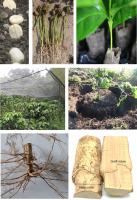Scientia Horticulturae ( IF 3.9 ) Pub Date : 2023-06-02 , DOI: 10.1016/j.scienta.2023.112162 Athina Koutouleas , Conor Blunt , Aljoša Bregar , Jon Kehlet Hansen , Anders Ræbild , Hervé Etienne , Frédéric Georget

|
Interspecific grafting of Coffea arabica scions on C. canephora rootstock has been proposed as a strategy against nematode infestation, but also for cultivation of coffee under environmental stressors (such as temperature extremes). An agroforestry-like microclimate was established using artificial shade nets (30% light interception) across a multi-site elevation trial (from 1000 to 1450 m above sea level) in Costa Rica (Alajuela region). The effects of interspecific grafting of scions from modern C. arabica varieties (‘Villa Sarchi’ and an F1 hybrid called ‘H3’) onto C. canephora (‘Nemaya’) rootstock were tested under these conditions. The interactions between grafting, genotype and elevation were determined on the above- and below ground growth, agronomic traits, photosynthesis as well as bean and cup qualities.
Variation in the protuberance of the graft union (trunk vs. below graft union collar diameters) were detected. However, no physical vascular blockages were observed in any of the interspecific grafted plants. Generally, interspecific grafting negatively affected most aerial and root traits as well bean yields for both ‘H3’ and ‘Villa Sarchi’ varieties compared to the non-grafted plants. A significant reduction in the photosynthesis of grafted ‘H3’ (in terms of Vcmax and ΦCO2max) was also observed. However, there were no impacts of grafting on the final bean attributes nor cup quality. Genetics of the scions largely determined coffee yields, with higher yields produced by ‘H3’ compared to ‘Villa Sarchi’. The scion also controlled agronomic traits, bean qualities and belowground biomass (dry weight of taproot, secondary root mass and overall root system). This was observed when either C. arabica or C. canephora scion material was used. Increasing elevation significantly reduced the trunk, branches and shoot system, chlorophyll fluorescence parameters and other agronomic traits. However no significant interactions were found between grafting and elevation (within the range tested). Our results show how interspecific grafting of C. arabica onto C. canephora can reduce plant biomass and productivity under shade and across an elevational gradient, especially when the composite plant involves a vigorous and high yielding F1 hybrid.
中文翻译:

小粒咖啡种间嫁接和海拔对哥斯达黎加咖啡生长、产量和品质属性的影响
已提出将小粒咖啡接穗种间嫁接在C. canephora砧木上作为对抗线虫侵扰的策略,但也可用于在环境压力因素(如极端温度)下种植咖啡。在哥斯达黎加(阿拉胡埃拉地区)的多点海拔试验(海拔 1000 至 1450 米)中,使用人工遮阳网(30% 的光拦截)建立了类似农林业的小气候。现代C. arabica品种('Villa Sarchi' 和称为 'H3' 的 F1 杂交种)的种间嫁接对C. canephora的影响('Nemaya') 砧木在这些条件下进行了测试。嫁接、基因型和海拔之间的相互作用取决于地上和地下生长、农艺性状、光合作用以及豆和杯的品质。
检测到移植物结合突起的变化(主干与移植物结合环直径以下)。然而,在任何种间嫁接植物中都没有观察到物理血管阻塞。一般来说,与非嫁接植物相比,种间嫁接对“H3”和“Villa Sarchi”品种的大多数气生和根性状以及豆类产量产生了负面影响。嫁接的“H3”的光合作用显着降低(根据 V cmax和 ΦCO 2max) 也被观察到。然而,嫁接对最终咖啡豆的属性和杯测质量没有影响。接穗的遗传学在很大程度上决定了咖啡产量,与“Villa Sarchi”相比,“H3”的产量更高。接穗还控制农艺性状、豆类品质和地下生物量(主根干重、次生根质量和整个根系)。当使用C. arabica或C. canephora接穗材料时观察到这一点。海拔升高显着降低了树干、分枝和地上部系统、叶绿素荧光参数和其他农艺性状。然而,在移植和提升之间没有发现显着的相互作用(在测试范围内)。我们的结果显示了小粒咖啡的种间嫁接到C. canephora可以降低阴影下和跨越海拔梯度的植物生物量和生产力,特别是当复合植物涉及有活力和高产的 F1 杂种时。











































 京公网安备 11010802027423号
京公网安备 11010802027423号